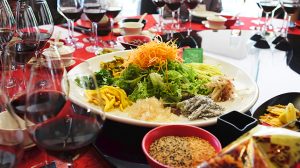By IVAN SHIU (Xiao Junwen)
When speaking with wine distributors, a common sentiment often arises: Why does the wine we enjoy in Italy taste better than the same bottle consumed in China? Aside from factors like transportation and storage, the most important reason is actually the food. Imagine dining in an Italian restaurant—there’s always a wide variety of wines available, and both chefs and servers are well-versed in wine. Italian dishes paired with local wines are simply a delight.
This is why I believe that if Italian wine is to further penetrate the Chinese market, it must focus on close collaboration with the food and beverage (F&B) sector. Fine wine and fine food are like a marriage—when harmoniously combined, they can drive both sales and brand influence across the market.
 So, how can we open up the restaurant channel for Italian wines? Here are my suggestions:
So, how can we open up the restaurant channel for Italian wines? Here are my suggestions:
1. Encourage and Support More Collaboration with Restaurants
 Many wineries invest heavily in trade fairs each year, believing that finding a distributor is the key to reaching buyers. However, they often overlook a crucial point: supporting existing distributors in expanding their channels is far more effective.
Many wineries invest heavily in trade fairs each year, believing that finding a distributor is the key to reaching buyers. However, they often overlook a crucial point: supporting existing distributors in expanding their channels is far more effective.
I recommend that overseas wineries and brands allocate more funds to support their distributors in working with restaurant chains. This includes funding in-restaurant promotions such as wine displays, sample tastings, and more wine-pairing events. By approaching the market from the end-user’s perspective, we can influence the channel and increase awareness of Italian wines. When consumers experience how well Italian wine pairs with food, it leads to a stronger impression and increased consumption.
 2. Promote Pairings of Italian Wine with Chinese Cuisine
2. Promote Pairings of Italian Wine with Chinese Cuisine
Many people still view wine as a Western product, suitable only for Western cuisine. But Chinese food is our everyday life. If wine is only reserved for Western meals, its everyday relevance will remain limited.
That’s why promoting Italian wine alongside Chinese cuisine is one of the most effective marketing strategies. We could invite renowned Chinese chefs to select their signature dishes and then pair them with Italian wines. For instance, Prosecco—with its versatile and fresh character—pairs exceptionally well with Chinese cuisine, whether it’s Cantonese dim sum or more complex dishes, enhancing the overall dining experience.
Another great example is Primitivo, a grape known for its rich fruit and slightly sweet notes. It matches well with the many spicy cuisines across China, including dishes from Anhui, Hubei, Hunan, Chongqing, Sichuan, Yunnan, Guizhou, and Guangxi. Primitivo not only complements the flavors but also helps temper the spiciness, offering a pleasant drinking experience.
With the right promotional strategy and partnerships with key F&B influencers and platforms, we can raise awareness and appreciation of how well Italian wine pairs with Chinese cuisine.
 3. Host More Restaurant-Focused Masterclasses and Events
3. Host More Restaurant-Focused Masterclasses and Events
To further promote the synergy between Italian wine and Chinese food, masterclasses are essential. Italian wine associations should invest more time and resources in hosting these events across China.
These sessions could target chefs and restaurant professionals, educating them on suitable Italian wine pairings. Additionally, more budget should be allocated to wine & food festivals aimed at businesses and end buyers. Italian-themed food promotions in shopping malls and restaurant chains would also help introduce Italian wines to a wider audience.
Wine is a traditional industry, but if we continue to stick to the old ways, we will only feel the impact of a declining market more acutely. I boldly believe that without a change in strategy, particularly when it comes to how Italian wine is promoted in China, it will remain an uphill battle. Strengthening partnerships with the F&B sector offers a promising path forward.
 Let’s hope that in the near future, we’ll see Italian wines featured more prominently in restaurants across China—enjoyed and loved alongside Chinese cuisine.
Let’s hope that in the near future, we’ll see Italian wines featured more prominently in restaurants across China—enjoyed and loved alongside Chinese cuisine.




